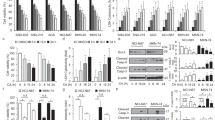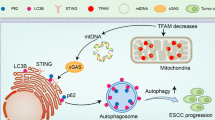Abstract
Autophagy and endoplasmic reticulum (ER) stress response is important for cancer cells to maintain malignancy and resistance to therapy. trans-Resveratrol (RSV), a non-flavonoid agent, has been shown to induce apoptosis in human nasopharyngeal carcinoma (NPC) cells. In this study, the involvements of tumor-specific ER stress and autophagy in the RSV-mediated apoptosis were investigated. In addition to traditional autophagosomes, the images of transmission electron microscopy (TEM) indicated that RSV markedly induced larger, crescent-shaped vacuoles with single-layered membranes whose the expanded cisternae contains multi-lamellar membrane structures. Prolonged exposure to RSV induced a massive accumulation of ER expansion. Using an EGFP-LC3B transfection and confocal laser microscopy approach, we found RSV-induced EGFP-LC3 puncta co-localized with ER-tracker red dye, implicating the involvement of LC3II in ER expansion. The proapoptotic effect of RSV was enhanced after suppression of autophagy by ATG7 siRNA or blocking the autophagic flux by bafilomycin A1, but that was not changed after targeted silence of IRE1 or CHOP by siRNA. Using caspase inhibitors, we demonstrated the upregulation of caspase-12 (casp12) and the activation of casp4 were associated with the proapoptotic induction of RSV through the caspase-9/caspase-3 pathway. Intriguingly, siRNA knockdown of casp12, but not caspase-4, decreased the susceptibility of the NPC cells to RSV-mediated apoptosis. Further, we showed that RSV dose-dependently increased the ceramide accumulation as assessed by LC–MS/MS system. Using serine palmitoyltransferase (SPT, a key enzyme of de novo ceramide biosynthesis) inhibitors (l-cycloserine and myriocin), we found the increased ceramide accumulation was strongly correlated with the proapoptotic potential of RSV. This study revealed the ER expansion and upregulation of ER casp12 together may indicate profound biological effects of RSV and contributed to NPC cell death. Targeting the different status of ER stress may provide a possible strategy for cancer treatments.









Similar content being viewed by others
References
Xu CY, Bailly-Maitre B, Reed JC (2005) Endoplasmic reticulum stress: cell life and death decisions. J Clin Investig 115:2656–2664
Schönthal AH (2013) Pharmacological targeting of endoplasmic reticulum stress signaling in cancer. Biochem Pharmacol 85:653–666
Li XM, Zhang KH, Li ZH (2011) Unfolded protein response in cancer: the physician’s perspective. J Hematol Oncol 4:8. doi:10.1186/1756-8722-4-8
Verfaillie T, Salazar M, Velasco G, Agostinis P (2010) Linking ER Stress to autophagy: potential implications for cancer therapy. Int J Cell Biol. doi:10.1155/2010/930509
Walker D (2010) Autophagy: a new link in the chain. Nat Rev Mol Cell Biol 11:604–605
Bernales S, Schuck S, Walter P (2007) ER-phagy: selective autophagy of the endoplasmic reticulum. Autophagy 3:285–287
Codogno P, Mehrpour M, Proikas-Cezanne T (2011) Canonical and non-canonical autophagy: variations on a common theme of self-eating? Nat Rev Mol Cell Biol 13:7–12
Jing G, Wang JJ, Zhang SX (2012) ER stress and apoptosis: a new mechanism for retinal cell death. Exp Diabetes Res. doi:10.1155/2012/589589
Hitomi J, Katayama T, Eguch Y, Kudo T, Taniguchi M, Koyama Y, Manabe T, Yamagishi S, Bando Y, Imaizumi K, Tsujimoto Y, Tohyama M (2004) Involvement of caspase-4 in endoplasmic reticulum stress-induced apoptosis and Aβ-induced cell death. J Cell Biol 165:347–356. doi:10.1083/jcb.200310015
Nakagawa T, Zhu H, Morishima N, Li E, Xu J, Yuan BA, Yankner J (2000) Caspase-12 mediates endoplasmic-reticulum-specific apoptosis and cytotoxicity by amyloid-[beta]. Nature 403:98–103
Yoneda T, Imaizumi K, Oono K, Yui D, Gom F, Katayama T, Tohyama M (2001) Activation of caspase-12, an endoplastic reticulum (ER) resident caspase, through tumor necrosis factor rceptor-associated factor 2-dependent mechanism in response to the ER stress. J Biol Chem 276:13935–13940
Morishima N, Nakanishi K, Takenouchi H, Shibata T, Yasuhiko Y (2002) An endoplasmic reticulum stress-specific caspase cascade in apoptosis: cytochrome C-independent activation of caspase-9 by caspase-12. J Biol Chem 277:34287–34294
Saleh M, Vaillancourt JP, Graham RK, Huyck M, Srinivasula SM, Alnemri ES, Steinberg MH, Nolan V, Baldwin CT, Hotchkiss RS, Buchman TG, Zehnbauer BA, Hayden MR, Farrer LA, Roy S, Nicholson DW (2004) Differential modulation of endotoxin responsiveness by human caspase-12 polymorphisms. Nature 429:75–79
Cheng CY, Su CC (2010) Tanshinone IIA inhibits Hep-J5 cells by increasing calreticulin, caspase 12 and GADD153 protein expression. Int J Mol Med 26:379–385
Cheng CY, Lin YH, Su CC (2010) Curcumin inhibits the proliferation of human hepatocellular carcinoma J5 cells by inducing endoplasmic reticulum stress and mitochondrial dysfunction. Int J Mol Med 26:673–678
Chauhan D, Singh AV, Ciccarelli B, Richardson PG, Palladino MA, Anderson KC (2010) Combination of novel proteasome inhibitor NPI-0052 and lenalidomide trigger in vitro and in vivo synergistic cytotoxicity in multiple myeloma. Blood 115:834–845
Brezniceanu ML, Lau CJ, Godin N, Chénier I, Duclos A, Éthier J, Filep JG, Ingelfinger JR, Zhang SL, Chan JS (2010) Reactive oxygen species promote caspase-12 expression and tubular apoptosis in diabetic nephropathy. J Am Soc Nephrol 21:943–954
Wang FM, Galson DL, Roodman GD, Ouyang H (2011) Resveratrol triggers the pro-apoptotic endoplasmic reticulum stress response and represses pro-survival XBP1 signaling in human multiple myeloma cells. Exp Hematol 39:999–1006
Pattingre S, Bauvy C, Levade T, Levine B, Codogno P (2009) Ceramide-induced autophagy: to junk or to protect cells? Autophagy 5:558–560
Mauthe M, Jacob A, Freiberger S, Hentschel K, Stierhof YD, Codogno P, Proikas-Cezanne T (2011) Resveratrol-mediated autophagy requires WIPI-1-regulated LC3 lipidation in the absence of induced phagophore formation. Autophagy 7:1448–1461
Scarlatti F, Scarlatti F, Sala G, Somenzi G, Signorelli P, Sacchi N, Ghidoni R (2003) Resveratrol induces growth inhibition and apoptosis in metastatic breast cancer cells via de novo ceramide signaling. FASEB J 17:2339–2341
Lin CT, Wong CI, Chan WY, Tzung KW, Ho JK, Hsu MM, Chuang SM (1990) Establishment and characterization of two nasopharyngeal carcinoma cell lines. Lab Investig 62:713–724
Chow SE, Chen YW, Liang CA, Huang YK, Wang JS (2012) Wogonin induces cross-regulation between autophagy and apoptosis via a variety of Akt pathway in human nasopharyngeal carcinoma cells. J Cell Biochem 113:3476–3485
Chow SE, Chang YL, Chuang SF, Wang JS (2011) Wogonin induced apoptosis in human nasopharyngeal carcinoma cells by targeting GSK-3β and ΔNp63. Cancer Chemother Pharmacol 68:835–845
Zhang K, Haynes T-AS, Filippova M, Filippov V, Duerksen-Hughes PJ (2011) Quantification of ceramide levels in mammalian cells by high performance liquid chromatography coupled to tandem mass spectrometry with multiple-reaction-monitoring mode (HPLC–MS/MS-MRM). Anal Method 3:1193–1197
Mizushima N, Ohsumi Y, Yoshimori T (2002) Autophagosome formation in mammalian cells. Cell Struct Funct 27:421–429
Mizushima N, Yoshimori T, Levine B (2010) Methods in mammalian autophagyresearch. Cell 140:313–326
Peng G, Li L, Liu Y, Pu J, Zhang S, Yu J, Zhao J, Liu P (2011) Oleate blocks palmitate-induced abnormal lipid distribution, endoplasmic reticulum expansion and stress, and insulin resistance in skeletal muscle. Endocrinol 152:2206–2218
Bernales S, McDonald KL, Walter P (2006) Autophagy counterbalances endoplasmic reticulum expansion during the unfolded protein response. PLoS Biol 4:e423. doi:10.1371/journal.pbio.0040423
Tanida I, Minematsu-Ikeguchi N, Ueno T, Kominami E (2005) Lysosomal turnover, but not a cellular level, of endogenous LC3 is a marker for autophagy. Autophagy 1:84–91
Yamaguchi H, Wang HG (2004) CHOP is Involved in endoplasmic reticulum stress-induced apoptosis by enhancing DR5 expression in human carcinoma cells. J Biol Chem 279:45495–45502
Kerbiriou M, Teng L, Benz N, Trouvé P, Férec C (2009) The calpain, caspase 12, caspase 3 cascade leading to apoptosis is altered in F508del-CFTR expressing cells. PLoS One 4:e8436. doi:10.1371/journal.pone.0008436
Pettus BJ, Chalfant CE, Hannun YA (2002) Ceramide in apoptosis: an overview and current perspectives. Biochim Biophys Acta 1585:114–125
Huang T-T, Lin H-C, Chen C-C, Lu C-C, Wei C-F, Wu T-S, Liu F-G, Lai H-C (2011) Resveratrol induces apoptosis of human nasopharyngeal carcinoma cells via activation of multiple apoptotic pathways. J Cell Physiol 226:720–728
Chow SE, Wang JS, Chuang SF, Chang YL, Chu WK, Chen WS, Chen YW (2010) Resveratrol-induced p53-independent apoptosis of human nasopharyngeal carcinoma cells is correlated with the downregulation of ΔNp63. Cancer Gene Ther 17:872–882
Cottart C, Nivet-Antoine V, Laguillier-Morizot C, Beaudeux J (2010) Resveratrol bioavailability and toxicity in humans. Mol Nutr Food Res 54:7–16
Shu X-H, Li H, Sun Z, Wu M-L, Ma J-X, Wang J-M, Wang Q, Sun Y, Fu Y-S, Chen X-Y, Kong Q-Y, Liu J (2010) Identification of metabolic pattern and bioactive form of resveratrol in human medulloblastoma cells. Biochem Pharmacol 79:1516–1525
Giovannelli L, Pitozzi V, Jacomelli M, Mulinacci N, Laurenzana A, Dolara P, Mocali A (2011) Protective effects of resveratrol against senescence-associated changes in cultured human fibroblasts. J Gerontol A Biol Sci Med Sci 66A:9–18
Florey O, Kim SE, Sandoval CP, Haynes CM, Overholtzer M (2011) Autophagy machinery mediates macroendocytic processing and entotic cell death by targeting single membranes. Nat Cell Biol 13:1335–1343
Acknowledgments
This work was supported by Chang Gung Memorial Hospital & Chang Gung University. Contract Grant Number: CMRPD 1B0231, CMRPD 5C0011 and EMRPD 1C0271.
Author information
Authors and Affiliations
Corresponding author
Rights and permissions
About this article
Cite this article
Chow, SE., Kao, CH., Liu, YT.A. et al. Resveratrol induced ER expansion and ER caspase-mediated apoptosis in human nasopharyngeal carcinoma cells. Apoptosis 19, 527–541 (2014). https://doi.org/10.1007/s10495-013-0945-0
Published:
Issue Date:
DOI: https://doi.org/10.1007/s10495-013-0945-0




